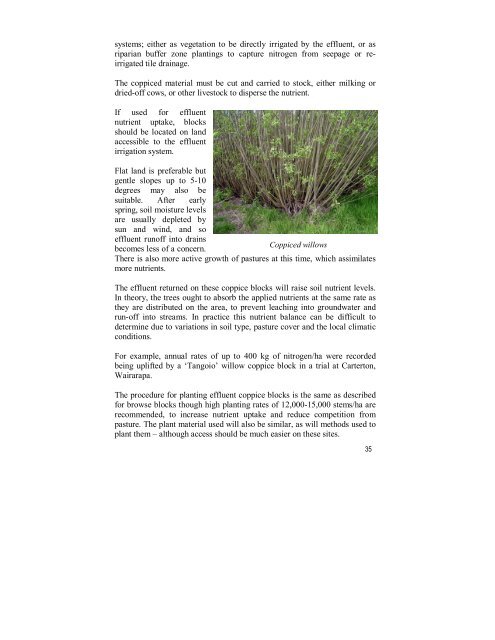Growing Poplar and Willow Trees on Farms, National - FAO
Growing Poplar and Willow Trees on Farms, National - FAO
Growing Poplar and Willow Trees on Farms, National - FAO
Create successful ePaper yourself
Turn your PDF publications into a flip-book with our unique Google optimized e-Paper software.
systems; either as vegetati<strong>on</strong> to be directly irrigated by the effluent, or as<br />
riparian buffer z<strong>on</strong>e plantings to capture nitrogen from seepage or reirrigated<br />
tile drainage.<br />
The coppiced material must be cut <str<strong>on</strong>g>and</str<strong>on</strong>g> carried to stock, either milking or<br />
dried-off cows, or other livestock to disperse the nutrient.<br />
If used for effluent<br />
nutrient uptake, blocks<br />
should be located <strong>on</strong> l<str<strong>on</strong>g>and</str<strong>on</strong>g><br />
accessible to the effluent<br />
irrigati<strong>on</strong> system.<br />
Flat l<str<strong>on</strong>g>and</str<strong>on</strong>g> is preferable but<br />
gentle slopes up to 5-10<br />
degrees may also be<br />
suitable. After early<br />
spring, soil moisture levels<br />
are usually depleted by<br />
sun <str<strong>on</strong>g>and</str<strong>on</strong>g> wind, <str<strong>on</strong>g>and</str<strong>on</strong>g> so<br />
effluent runoff into drains<br />
becomes less of a c<strong>on</strong>cern.<br />
Coppiced willows<br />
There is also more active growth of pastures at this time, which assimilates<br />
more nutrients.<br />
The effluent returned <strong>on</strong> these coppice blocks will raise soil nutrient levels.<br />
In theory, the trees ought to absorb the applied nutrients at the same rate as<br />
they are distributed <strong>on</strong> the area, to prevent leaching into groundwater <str<strong>on</strong>g>and</str<strong>on</strong>g><br />
run-off into streams. In practice this nutrient balance can be difficult to<br />
determine due to variati<strong>on</strong>s in soil type, pasture cover <str<strong>on</strong>g>and</str<strong>on</strong>g> the local climatic<br />
c<strong>on</strong>diti<strong>on</strong>s.<br />
For example, annual rates of up to 400 kg of nitrogen/ha were recorded<br />
being uplifted by a ‘Tangoio’ willow coppice block in a trial at Cartert<strong>on</strong>,<br />
Wairarapa.<br />
The procedure for planting effluent coppice blocks is the same as described<br />
for browse blocks though high planting rates of 12,000-15,000 stems/ha are<br />
recommended, to increase nutrient uptake <str<strong>on</strong>g>and</str<strong>on</strong>g> reduce competiti<strong>on</strong> from<br />
pasture. The plant material used will also be similar, as will methods used to<br />
plant them – although access should be much easier <strong>on</strong> these sites.<br />
35

















